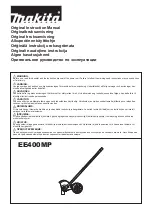
IonPac CS14 Manual
Doc. No. 034848-10
Page 22 of 54
5.7
Isocratic Elution of Morpholine and Resolution Enhancement Addition of Solvent to Eluent
The organic solvent, acetonitrile, can be used to control the IonPac CS14 cation exchange selectivity of morpholine and
methyl amines. The solvent compatibility of the IonPac CS14 permits the use of HPLC organic solvents in the eluent to modify
ion exchange selectivity. The first example illustrates the use of acetonitrile in the eluent to optimize the separation of the
closely eluting analyte pairs, morpholine and magnesium. The retention of the more hydrophobic member of the pair,
morpholine, is decreased more by the addition of solvent, improving resolution. The acetonitrile concentration is used to
optimize the positioning of morpholine between potassium and magnesium and improve the morpholine peak shape.
The third example illustrates the determination of trace levels of lithium, sodium, ammonium, potassium, magnesium and
calcium in a high purity power plant water treated with morpholine. 1.0 mL of sample was concentrated on a CG14 guard column
and then analyzed. The sample was concentrated and then run on a 2-mm system for economy of operation.
Sample Loop Volume:
6.25 µL (2-mm), 25 µL (4-mm)
Analytical Column:
IonPac CS14 Analytical Column
Eluent:
See Chromatogram
Eluent Flow Rate:
0.25 mL/min (2-mm), 1.0 mL/min (4-mm)
SRS Suppressor:
Cation Self-Regenerating Suppressor, CSRS ULTRA (2-mm or 4-mm)
Recycle Mode
or MMS Suppressor:
Cation MicroMembrane Suppressor, CMMS III (2-mm or 4-mm)
MMS Regenerant:
100 mN TBAOH
(tetrabutylammonium hydroxide)
Expected Background Conductivity:
< 3 µS
Storage Solution:
Eluent
















































